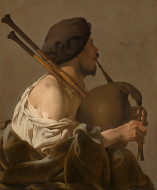
|
Hendrick ter Brugghen Hendrick ter Brugghen (painter) Dutch, 1588 - 1629 Bagpipe Player, 1624 oil on canvas overall: 100.7 x 82.9 cm (39 5/8 x 32 5/8 in.) Paul Mellon Fund and Greg and Candy Fazakerley Fund 2009.24.1 On View |
Hendrick ter Brugghen (1588–1629), as no other Dutch artist, could capture the rhythms of music in the very way he composed his paintings. His musicians lean into their instruments, their bodies alive with the joy of the sounds they bring forth, whether coaxed from a violin, lute, recorder, or bagpipe. In this remarkable image a bagpipe player, seen in strict profile, squeezes the leather bag between his forearms as he blows through the instrument's pipe and fingers a tune on the chanter. Two large drones, composed of different wooden sections, rest on his bare shoulder. The interlocking rhythms of this ensemble—the round shapes of the musician's shoulder, beret, and brown bagpipe bag, the flowing patterns of folds in his creamy shirt and taupe robe, the pronounced diagonals of the drones and pipe, and the verticality of the chanter—parallel those of a musical score. One can almost imagine hearing the bagpipes' broad, fulsome notes, followed by quickly cadenced flourishes and strong beats that not only punctuate melodies with dynamic accents but also culminate in a well-defined and emphatic finale.
Ter Brugghen's painting, while muted in tonality, is both bold and forceful in its scale and painting techniques. The musician is shown larger than life-size and his form fills the picture plane. The artist's sure brushstrokes flow across the canvas, reflecting in their energy the bagpipe player's passion for his music. The numerous adjustments the artist made in the folds of the shirt and robe, as well as in the shape of the bagpipes, indicate the freedom with which he approached his subject. Also astonishing is Ter Brugghen's control of light, which falls most strongly on the bagpipe player's shoulder, shirt, and fingers while leaving his face in shadow—evidence that the painting focuses primarily on the sensuality of music and not on a specific individual.
The bagpipe player is a muscular, rough-hewn type, hardly an ideal of grace and refinement. His head is large, his nose round, and he sports a shepherd's mustache and beard. His hands and knuckles are thick, yet from the manner in which he fingers the chanter, leaving the vent hole uncovered, it is clear that he understands how to play the instrument. Bagpipes were traditionally viewed as folk instruments, played by herdsmen and shepherds whiling away their time or at country dances. However, Ter Brugghen does not depict a local peasant or a shepherd the artist may have encountered on a foray into the countryside: shepherds did not play bagpipes with drones resting on a bare shoulder. The bagpiper's loosely draped robes reflect a manner of dress based on antique fashions (all'antica). This mode of dress alluded to an arcadian ideal of country existence that was popular in aristocratic and court circles and among the urban elite, particularly in Utrecht and The Hague. Essential to this mythology were not only the purity and bounty of country existence, but also the romantic ideals of love and beauty that derived from Renaissance literary and pictorial traditions.
The Bagpipe Player thus reflects the broad cultural interest in the pastoral during the early seventeenth century that evoked the idyllic pleasures of country living, particularly as experienced through music. Ter Brugghen fully embraced this theme in paintings of musicians and singers that capture both the joy and the sensuality of life. These remarkably engaging images invite us into a world where, through the artist's boldness of his brush and the rhythms of his forms, we feel the enduring power of music on the human spirit.
The specific character of the Bagpipe Player—a single, over-life-size musician, depicted against a plain grayish-ocher background—owes much to the influence of Gerrit van Honthorst and Dirck van Baburen, Dutch Caravaggist painters who returned to Utrecht from Rome in 1620. They brought with them stylistic and thematic predilections appropriate for expressing the sensuous, idealized concepts of arcadian subject matter that they adapted from paintings by Caravaggio and his followers, particularly Bartolomeo Manfredi. Ter Brugghen himself had undertaken a trip to Italy around 1608 after a short apprenticeship in Utrecht, possibly with the mannerist artist Abraham Bloemaert. Little in Ter Brugghen's early work, or even in his work after he returned to Utrecht in the fall of 1614 and joined the painter's guild, suggests that he fully embraced Caravaggio's bold, light-filled style of painting. Once Honthorst and Baburen returned in 1620, however, he quickly responded to the stylistic and thematic innovations of his younger contemporaries, whether depicting biblical, mythological, or genre scenes of figures playing musical instruments, a subject he continued to paint until his death in 1629. He may even have formed a workshop with Baburen.
In 1624, the date of the Bagpipe Player, Ter Brugghen fully turned his attention to the depiction of musicians. In that year he painted no fewer than five separate compositions devoted to music, featuring not only bagpipe players but also musicians—sometimes singing—who play the lute and the violin. He continued this interest in the years to follow. Just what prompted this change is not known, but the appeal of this subject was such that Ter Brugghen and/or his workshop made replicas of a number of these works, including the Bagpipe Player. This is the first work by one of the Utrecht Caravaggisti to enter the Gallery's collection.

